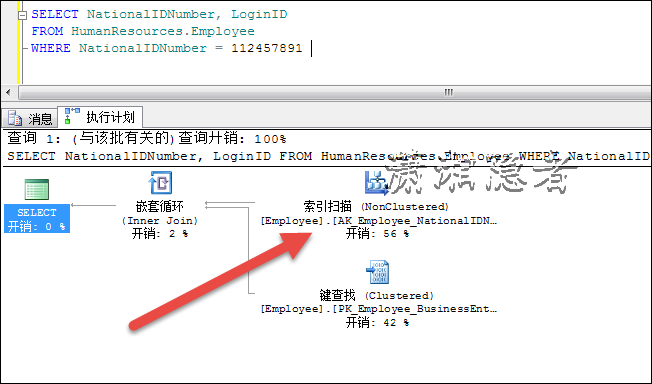SQL Server 中什麼情況會導致其執行計劃從索引查找(Index Seek)變成索引掃描(Index Scan)呢? 下面從幾個方面結合上下文具體場景做了下測試、總結、歸納。
1:隱式轉換會導致執行計劃從索引查找(Index Seek)變為索引掃描(Index Scan)
Implicit Conversion will cause index scan instead of index seek. While implicit conversions occur in SQL Server to allow data evaluations against different data types, they can introduce performance problems for specific data type conversions that result in an index scan occurring during the execution. Good design practices and code reviews can easily prevent implicit conversion issues from ever occurring in your design or workload.
如下示例,AdventureWorks2014數據庫的HumanResources.Employee表,由於NationalIDNumber字段類型為NVARCHAR,下面SQL發生了隱式轉換,導致其走索引掃描(Index Scan)
SELECT NationalIDNumber, LoginID FROM HumanResources.Employee WHERE NationalIDNumber = 112457891

我們可以通過兩種方式避免SQL做隱式轉換:
1:確保比較的兩者具有相同的數據類型。
2:使用強制轉換(explicit conversion)方式。
我們通過確保比較的兩者數據類型相同後,就可以讓SQL走索引查找(Index Seek),如下所示
SELECT nationalidnumber,
loginid
FROM humanresources.employee
WHERE nationalidnumber = N'112457891'
![clipboard[1] clipboard[1]](https://www.aspphp.online/shujuku/UploadFiles_3118/201701/2017012118391884.png)
注意:並不是所有的隱式轉換都會導致索引查找(Index Seek)變成索引掃描(Index Scan),Implicit Conversions that cause Index Scans 博客裡面介紹了那些數據類型之間的隱式轉換才會導致索引掃描(Index Scan)。如下圖所示,在此不做過多介紹。
![clipboard[2] clipboard[2]](https://www.aspphp.online/shujuku/UploadFiles_3118/201701/2017012118391981.png)
![clipboard[3] clipboard[3]](https://www.aspphp.online/shujuku/UploadFiles_3118/201701/2017012118391986.png)
避免隱式轉換的一些措施與方法
1:良好的設計和代碼規范(前期)
2:對發布腳本進行Rreview(中期)
3:通過腳本查詢隱式轉換的SQL(後期)
下面是在數據庫從執行計劃中搜索隱式轉換的SQL語句
SET TRANSACTION ISOLATION LEVEL READ UNCOMMITTED
DECLARE @dbname SYSNAME
SET @dbname = QUOTENAME(DB_NAME());
WITH XMLNAMESPACES
(DEFAULT 'http://schemas.microsoft.com/sqlserver/2004/07/showplan')
SELECT
stmt.value('(@StatementText)[1]', 'varchar(max)'),
t.value('(ScalarOperator/Identifier/ColumnReference/@Schema)[1]', 'varchar(128)'),
t.value('(ScalarOperator/Identifier/ColumnReference/@Table)[1]', 'varchar(128)'),
t.value('(ScalarOperator/Identifier/ColumnReference/@Column)[1]', 'varchar(128)'),
ic.DATA_TYPE AS ConvertFrom,
ic.CHARACTER_MAXIMUM_LENGTH AS ConvertFromLength,
t.value('(@DataType)[1]', 'varchar(128)') AS ConvertTo,
t.value('(@Length)[1]', 'int') AS ConvertToLength,
query_plan
FROM sys.dm_exec_cached_plans AS cp
CROSS APPLY sys.dm_exec_query_plan(plan_handle) AS qp
CROSS APPLY query_plan.nodes('/ShowPlanXML/BatchSequence/Batch/Statements/StmtSimple') AS batch(stmt)
CROSS APPLY stmt.nodes('.//Convert[@Implicit="1"]') AS n(t)
JOIN INFORMATION_SCHEMA.COLUMNS AS ic
ON QUOTENAME(ic.TABLE_SCHEMA) = t.value('(ScalarOperator/Identifier/ColumnReference/@Schema)[1]', 'varchar(128)')
AND QUOTENAME(ic.TABLE_NAME) = t.value('(ScalarOperator/Identifier/ColumnReference/@Table)[1]', 'varchar(128)')
AND ic.COLUMN_NAME = t.value('(ScalarOperator/Identifier/ColumnReference/@Column)[1]', 'varchar(128)')
WHERE t.exist('ScalarOperator/Identifier/ColumnReference[@Database=sql:variable("@dbname")][@Schema!="[sys]"]') = 1
2:非SARG謂詞會導致執行計劃從索引查找(Index Seek)變為索引掃描(Index Scan)
SARG(Searchable Arguments)又叫查詢參數, 它的定義:用於限制搜索的一個操作,因為它通常是指一個特定的匹配,一個值的范圍內的匹配或者兩個以上條件的AND連接。不滿足SARG形式的語句最典型的情況就是包括非操作符的語句,如:NOT、!=、<>;、!<;、!>;NOT EXISTS、NOT IN、NOT LIKE等,另外還有像在謂詞使用函數、謂詞進行運算等。
2.1:索引字段使用函數會導致索引掃描(Index Scan)
SELECT nationalidnumber,
loginid
FROM humanresources.employee
WHERE SUBSTRING(nationalidnumber,1,3) = '112'
![clipboard[4] clipboard[4]](https://www.aspphp.online/shujuku/UploadFiles_3118/201701/2017012118391919.png)
2.2索引字段進行運算會導致索引掃描(Index Scan)
對索引字段字段進行運算會導致執行計劃從索引查找(Index Seek)變成索引掃描(Index Scan):
SELECT * FROM Person.Person WHERE BusinessEntityID + 10 < 260
![clipboard[5] clipboard[5]](https://www.aspphp.online/shujuku/UploadFiles_3118/201701/2017012118391957.png)
一般要盡量避免這種情況出現,如果可以的話,盡量對SQL進行邏輯轉換(如下所示)。雖然這個例子看起來很簡單,但是在實際中,還是見過許多這樣的案例,就像很多人知道抽煙有害健康,但是就是戒不掉!很多人可能了解這個,但是在實際操作中還是一直會犯這個錯誤。道理就是如此!
SELECT * FROM Person.Person WHERE BusinessEntityID < 250
![clipboard[6] clipboard[6]](https://www.aspphp.online/shujuku/UploadFiles_3118/201701/2017012118392034.png)
2.3 LIKE模糊查詢回導致索引掃描(Index Scan)
Like語句是否屬於SARG取決於所使用的通配符的類型, LIKE 'Condition%' 就屬於SARG、LIKE '%Condition'就屬於非SARG謂詞操作
SELECT * FROM Person.Person WHERE LastName LIKE 'Ma%'
![clipboard[7] clipboard[7]](https://www.aspphp.online/shujuku/UploadFiles_3118/201701/2017012118392050.png)
SELECT * FROM Person.Person WHERE LastName LIKE '%Ma%'
![clipboard[8] clipboard[8]](https://www.aspphp.online/shujuku/UploadFiles_3118/201701/2017012118392085.png)
3:SQL查詢返回數據頁(Pages)達到了臨界點(Tipping Point)會導致索引掃描(Index Scan)或表掃描(Table Scan)
What is the tipping point? It's the point where the number of rows returned is "no longer selective enough". SQL Server chooses NOT to use the nonclustered index to look up the corresponding data rows and instead performs a table scan.
關於臨界點(Tipping Point),我們下面先不糾結概念了,先從一個鮮活的例子開始吧:
SET NOCOUNT ON; DROP TABLE TEST CREATE TABLE TEST (OBJECT_ID INT, NAME VARCHAR(8)); CREATE INDEX PK_TEST ON TEST(OBJECT_ID) DECLARE @Index INT =1; WHILE @Index <= 10000 BEGIN INSERT INTO TEST SELECT @Index, 'kerry'; SET @Index = @Index +1; END UPDATE STATISTICS TEST WITH FULLSCAN; SELECT * FROM TEST WHERE OBJECT_ID= 1
如上所示,當我們查詢OBJECT_ID=1的數據時,優化器使用索引查找(Index Seek)
![clipboard[9] clipboard[9]](https://www.aspphp.online/shujuku/UploadFiles_3118/201701/2017012118392045.png)
上面OBJECT_ID=1的數據只有一條,如果OBJECT_ID=1的數據達到全表總數據量的20%會怎麼樣? 我們可以手工更新2001條數據。此時SQL的執行計劃變成全表掃描(Table Scan)了。
UPDATE TEST SET OBJECT_ID =1 WHERE OBJECT_ID<=2000; UPDATE STATISTICS TEST WITH FULLSCAN; SELECT * FROM TEST WHERE OBJECT_ID= 1
![clipboard[10] clipboard[10]](https://www.aspphp.online/shujuku/UploadFiles_3118/201701/2017012118392051.png)
![clipboard[11] clipboard[11]](https://www.aspphp.online/shujuku/UploadFiles_3118/201701/2017012118392199.png)
臨界點決定了SQL Server是使用書簽查找還是全表/索引掃描。這也意味著臨界點只與非覆蓋、非聚集索引有關(重點)。
Why is the tipping point interesting?
It shows that narrow (non-covering) nonclustered indexes have fewer uses than often expected (just because a query has a column in the WHERE clause doesn't mean that SQL Server's going to use that index)
It happens at a point that's typically MUCH earlier than expected… and, in fact, sometimes this is a VERY bad thing!
Only nonclustered indexes that do not cover a query have a tipping point. Covering indexes don't have this same issue (which further proves why they're so important for performance tuning)
You might find larger tables/queries performing table scans when in fact, it might be better to use a nonclustered index. How do you know, how do you test, how do you hint and/or force… and, is that a good thing?
4:統計信息缺失或不正確會導致索引掃描(Index Scan)
統計信息缺失或不正確,很容易導致索引查找(Index Seek)變成索引掃描(Index Scan)。 這個倒是很容易理解,但是構造這樣的案例比較難,一時沒有想到,在此略過。
5:謂詞不是聯合索引的第一列會導致索引掃描(Index Scan)
SELECT * INTO Sales.SalesOrderDetail_Tmp FROM Sales.SalesOrderDetail;
CREATE INDEX PK_SalesOrderDetail_Tmp ON Sales.SalesOrderDetail_Tmp(SalesOrderID, SalesOrderDetailID);
UPDATE STATISTICS Sales.SalesOrderDetail_Tmp WITH FULLSCAN;
下面這個SQL語句得到的結果是一致的,但是第二個SQL語句由於謂詞不是聯合索引第一列,導致索引掃描
SELECT * FROM Sales.SalesOrderDetail_Tmp WHERE SalesOrderID=43659 AND SalesOrderDetailID<10
![clipboard[12] clipboard[12]](https://www.aspphp.online/shujuku/UploadFiles_3118/201701/2017012118392169.png)
SELECT * FROM Sales.SalesOrderDetail_Tmp WHERE SalesOrderDetailID<10
![clipboard[13] clipboard[13]](https://www.aspphp.online/shujuku/UploadFiles_3118/201701/2017012118392178.png)